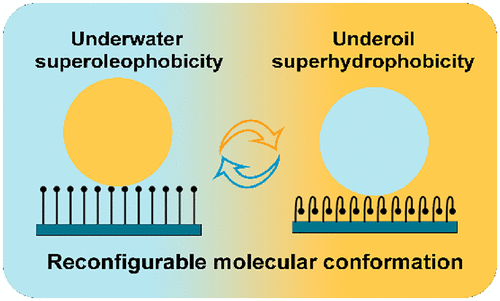Our official English website, www.x-mol.net, welcomes your feedback! (Note: you will need to create a separate account there.)
Molecular-Structure-Induced Under-Liquid Dual Superlyophobic Surfaces
ACS Nano ( IF 17.1 ) Pub Date : 2020-11-09 , DOI: 10.1021/acsnano.0c03977 Zhihong Zhao 1 , Yuzhen Ning 1 , Xu Jin 2 , Shuang Ben 1 , Jinlong Zha 1 , Bin Su 3 , Dongliang Tian 1 , Kesong Liu 1, 4 , Lei Jiang 1, 4
ACS Nano ( IF 17.1 ) Pub Date : 2020-11-09 , DOI: 10.1021/acsnano.0c03977 Zhihong Zhao 1 , Yuzhen Ning 1 , Xu Jin 2 , Shuang Ben 1 , Jinlong Zha 1 , Bin Su 3 , Dongliang Tian 1 , Kesong Liu 1, 4 , Lei Jiang 1, 4
Affiliation

|
Surfaces with under-water superoleophobicity or under-oil superhydrophobicity have attractive features due to their widespread applications. However, it is difficult to achieve under-liquid dual superlyophobic surfaces, that is, under-oil superhydrophobicity and under-water superoleophobicity coexistence, due to the thermodynamic contradiction. Herein, we report an approach to obtain the under-liquid dual superlyophobic surface through conformational transitions of surface self-assembled molecules. Preferential exposure of either hydrophobic or hydrophilic moieties of the hydroxythiol (HS(CH2)nOH, where n is the number of methylene groups) self-assembled monolayers to the surrounding solvent (water or oil) can be used to manipulate macroscopic wettability. In water, the surfaces modified with different hydroxythiols exhibit under-water superoleophobicity because of the exposure of hydroxyl groups. In contrast, surface wettability to water is affected by molecular orientation in oil, and the surface transits from under-oil superhydrophilicity to superhydrophobicity when n ≥ 4. This surface design can amplify the molecular-level conformational transition to the change of macroscopic surface wettability. Furthermore, on-demand oil/water separation relying on the under-liquid dual superlyophobicity is successfully demonstrated. This work may be useful in developing the materials with opposite superwettability.
中文翻译:

分子结构诱导的液下双超疏液表面
具有水下超疏油性或油超疏水性的表面由于其广泛的应用而具有吸引人的特征。但是,由于热力学上的矛盾,难以形成液下双重超疏液性的表面,即油下超疏水性和水下超疏油性并存。本文中,我们报告了一种通过表面自组装分子的构象转变获得液下双重超疏液表面的方法。优先暴露羟基硫醇的疏水或亲水部分(HS(CH 2)n OH,其中n自组装的单分子层与周围溶剂(水或油)的自组装单层,可用于控制宏观润湿性。在水中,由于羟基的暴露,用不同的羟基硫醇改性的表面表现出水下超疏油性。相反,表面的润湿性的水通过在油中的分子取向,并从下油超亲水表面转变为超疏水性时影响Ñ ≥4.该表面设计可以放大到宏观的表面润湿性的变化的分子水平的构象转变。此外,成功地证明了依赖于液体下双重超疏液性的按需油水分离。这项工作可能对开发具有相反超湿润性的材料很有用。
更新日期:2020-11-25
中文翻译:

分子结构诱导的液下双超疏液表面
具有水下超疏油性或油超疏水性的表面由于其广泛的应用而具有吸引人的特征。但是,由于热力学上的矛盾,难以形成液下双重超疏液性的表面,即油下超疏水性和水下超疏油性并存。本文中,我们报告了一种通过表面自组装分子的构象转变获得液下双重超疏液表面的方法。优先暴露羟基硫醇的疏水或亲水部分(HS(CH 2)n OH,其中n自组装的单分子层与周围溶剂(水或油)的自组装单层,可用于控制宏观润湿性。在水中,由于羟基的暴露,用不同的羟基硫醇改性的表面表现出水下超疏油性。相反,表面的润湿性的水通过在油中的分子取向,并从下油超亲水表面转变为超疏水性时影响Ñ ≥4.该表面设计可以放大到宏观的表面润湿性的变化的分子水平的构象转变。此外,成功地证明了依赖于液体下双重超疏液性的按需油水分离。这项工作可能对开发具有相反超湿润性的材料很有用。


























 京公网安备 11010802027423号
京公网安备 11010802027423号